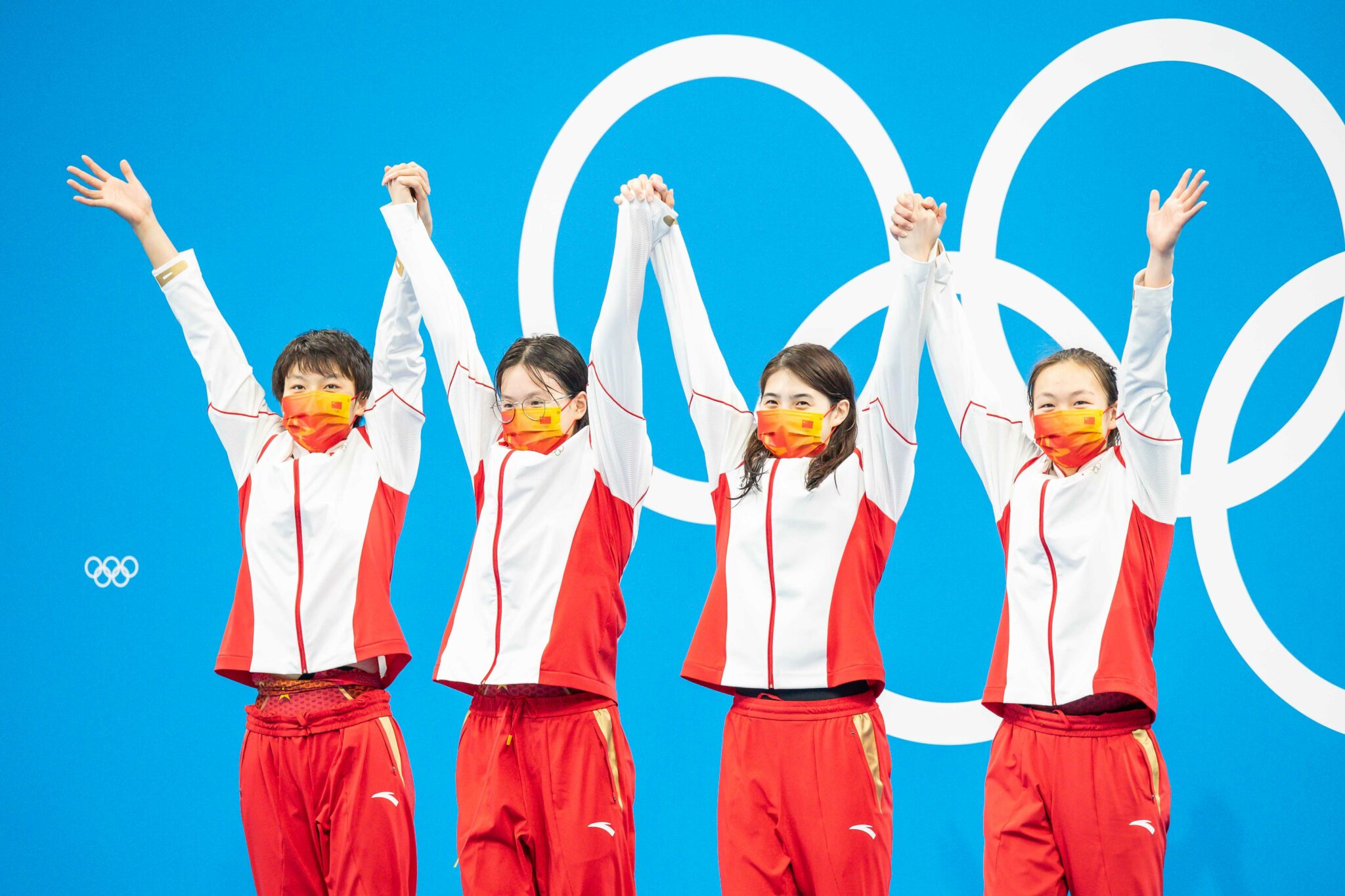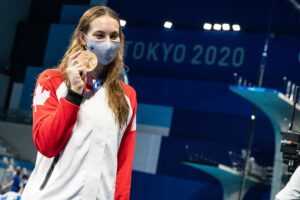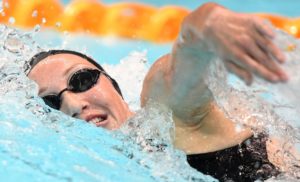
2022 FINA WORLD AQUATICS CHAMPIONSHIPS
Click here to see all of our 2022 World Championship Previews.
By The Numbers:
- World Record: China (Yang Junxuan, Tang Muhan, Zhang Yufei, Li Bingjie) – 7:40.33 (2021)
- Championship Record – Australia (Ariarne Titmus, Madi Wilson, Brianna Throssell, Emma McKeon) – 7:41.50 (2019)
- 2021 Olympic Champion – China (Yang Junxuan, Tang Muhan, Zhang Yufei, Li Bingjie) – 7:40.33
- 2019 World Champion – Australia (Ariarne Titmus, Madi Wilson, Brianna Throssell, Emma McKeon) – 7:41.50
There’s a lot going on in the women’s 4×200 free relay. And when I say a lot, I mean, a lot.
Last year, the story was simple. Australia was the defending World Champion and the world record holders that were heavily favored to win in Tokyo. Their depth in the 200 free was so strong to the point where they could fill their prelims and finals relay with four entirely different swimmers, and they had two 200 free Olympic medalists right at the tip of their fingers. In fact, the question was not if they would take gold, but how they would do so.
However, the narrative got a little more complicated when it was China who pulled off the shocker to win gold and break the world record at the Olympics, and a hail mary anchor leg from Katie Ledecky forced the Aussies into bronze medal position. In addition, Canada was just one 1:55 away from fighting for a spot on the podium.
This year, this race is less straightforward than it has been in the past. Australia still has the depth, but their top-end stars won’t be here. The United States didn’t have the greatest showing at trials. Canada has a lot of potential, they just need to put all their pieces together. And China, although they look strong and could defend their title, faces uncertainty due to the COVID-19 restrictions in their country.
Either way, the relay where three different countries got under the preexisting world record last year is shaping up to be one of the most exciting and unpredictable races in Budapest.
Does China Have What It Takes To Repeat?
We haven’t seen the Chinese compete at many meets in the 2021-22 season, but at the one meet that we did see from them, the 2021 Chinese National games, they looked really, really, good. They’ve got two 1:54-lows in Tang Muhan (1:54.26) and Yang Junxuan (1:54.48), with Lao Lihui (1:57.27) and Qiu Yuhan (1:57.33) following suit as the next two fastest swimmers in the nation.
Zhang Yufei (photo: Jack Spitser)
Most likely, the latter two will be replaced by Zhang Yufei and Li Bingjie on the relay, as they are both on the leaked Chinese World Championship roster. Yufei took on a grueling double last summer, breaking a textile world record to win Olympic gold in the 200 fly and then proceeding to split 1:55.60 on the 4×200 free relay. This year, she has to deal with the same exact thing: with the women’s 200 fly final being the first event on night five and the relay being the last event. There’s seven different races separating the two events, whereas in Tokyo there were only three, giving Yufei more time to recover and potentially go faster on the relay.
Bingjie, the Olympic bronze medalist in the 400 free, held off a charging Katie Ledecky when she anchored in a time of 1:55.30, a massive jump from the 1:59.03 she swam in the 200 free individually.
If the Chinese are as good as they were at the National Games and the Olympics in Budapest, they look poised to claim the throne once more. The one concern about them is how much their training has been affected by the COVID-19 pandemic. They already had their trials canceled in April due to the pandemic, and the Worlds team was selected based on “internal tests” at a national team training camp last month. In addition, many swimmers like Yufei who are training in Shanghai have had to face stringent pandemic restrictions that put their Worlds participation in jeopardy. However, Chinese Swimming News recently confirmed that the Shanghai swimmers would most likely be allowed to compete.
With a lack of competition opportunities in a year plagued by COVID-19 restrictions, can China live up to the hype they brought upon themselves last year?
Canada’s Untapped Potential
The Canadian women, who finished fourth last year, have a lot of options to go with on this relay. Most likely, they will be led by Penny Oleksiak and Summer McIntosh.

Penny Oleksiak (photo: Jack Spitser)
Oleksiak anchored in 1:55.14 on the Tokyo relay, although she was faster when she set her flat start best time of 1:54.70 in the individual 200 free and took home the bronze medal. Either way, she will probably be one of the fastest members of this relay. McIntosh won this race at Canadian trials by nearly two seconds, setting a new best time of 1:55.39. The 15-year-old superstar has been rapidly improving in all of her events, and is slowly establishing herself as a key component of this team. However, she’s dealing with the same 200 fly double as Yufei and is qualified to swim four different individual events, meaning that her heavy schedule (if she doesn’t scratch anything) could potentially factor into her performance on this relay.
Finishing behind McIntosh and Oleksiak at trials were Kayla Sanchez and Taylor Ruck.
Fourth-place Sanchez split 1:55.59 on the Tokyo relay and has been a consistent finals swimmer on Canada’s 4×200 free relays for the last few years, so expect to see her on the Budapest relay. Ruck, who finished third, could be one of the biggest variables for the Canadians. In 2018, she was the Pan Pacific champion in the 200 free, setting a Canadian record of 1:54.44 and splitting 1:54.08 on a relay. She was well off her best times after that, not even qualifying for the 4×200 in Tokyo after barely breaking two minutes at Canadian Olympic Trials. However, Ruck’s season best of 1:57.60 is the fastest she’s been since 2019, and she recently won an NCAA title in the 200 free despite being the 15th seed coming into the meet. If her performances are an indication that she’s at least close to returning to her best, this could be a very good sign for Canada.
Then there’s Rebecca Smith, who split 1:55.99 on the Tokyo prelims relay before adding and going 1:57.30 in finals. That doesn’t diminish her status as a strong relay swimmer though, as she was also the fastest leg (1:51.68) on Canada’s gold-medal-winning relay at last December’s Short Course World Championships, and finished second in the individual 200 free at the same meet. Although we know she’s capable of throwing down 1:55s, she finished sixth at Canadian trials in a time well off her best (1:58.48), meaning we might not see her on the finals relay this year.
If you add up the fastest relay splits of the four fastest Canadian women (McIntosh, Ruck, Sanchez, Oleksiak), you get a time of 7:39.73, which is faster than China’s world record. Although it’s very unlikely that everyone on the team will hit their best time at once, this just goes to show how much potential the Canadians have if everything goes right.
Australia’s Chance At Redemption
Many could argue that Australia not winning gold last year was a result of some questionable lineup decisions. One of the biggest controversies was leaving Mollie O’Callaghan off the finals relay, despite the fact that she led off the prelims relay in a world junior record time of 1:55.11 that ended up being faster than three out of the four Aussies that swam in finals.
This year, O’Callaghan made sure that her being on the finals relay would be a no-brainer decision for the Australian coaches. She was the second-fastest swimmer at trials (behind Ariarne Titmus, who won’t be swimming at Worlds), clocking a new best time of 1:54.94 – the fastest time in the world amongst swimmers racing in the individual 200 free. In less than a year, the 18-year-old went from being a prelims-only swimmer to the fastest amongst the group of veterans.

Lani Pallister, courtesy of Swimming Australia/Delly Carr
Behind O’Callaghan are six different sub-1:57 swimmers, with the fastest of them being Madi Wilson, Kiah Melverton, and Leah Neale. Melverton and sixth-place finisher Lani Pallister are ones to watch, as they both had breakout performances this year.
Melverton set a best time by over a second in the 400 free this March, but fell ill around the same time as trials and didn’t qualify individually. However, she still broke the 1:56 in the 200 free for the first time, finishing third in 1:55.94. If she’s in better shape come time for Worlds, we could be seeing an even bigger improvement trajectory from her. Pallister, who recently overcame heart surgery and an eating disorder, finished sixth with a personal best of 1:56.28 in addition to qualifying for the 400, 800, and 1500 free individually. Although she’s more geared towards the longer distances, be on the lookout for her on this relay as well, as she’s slowly establishing herself as one of Australia’s top freestylers this year.
The Aussies certainly have the depth in the 200 free despite missing their top two swimmers in Ariarne Titmus and Emma McKeon, but top-end strength is what wins medals. Even if they have a ton of women under 1:57, a team of 1:55-high and 1:56-low swimmers isn’t going to beat out countries like China, who have two of the top four 200 freestylers in the world this year despite not having the same depth as Australia. It’s just a matter of how much faster O’Callaghan can get, and who’s going to step up besides her.
| Swimmer | Season Best Time |
| Mollie O’Callaghan | 1:54.94 |
| Madi Wilson | 1:55.86 |
| Kiah Melverton | 1:55.94 |
| Leah Neale | 1:56.10 |
| Total | 7:42.84 |
Will Ledecky Be Enough To Carry The United States To A Medal?
Out of the top four teams from Tokyo, the United States will likely be the one struggling the most. Aside from Katie Ledecky, who won the 200 free at trials but decided not to swim it individually at Worlds, the fastest American this year is 15-year-old Claire Weinstein, who finished second in 1:57.04. And while Weinstein is faster than some of China and Canada’s top four, we know that those two countries have swimmers who can go faster than their trials times, whereas nobody in USA’s top six other than Ledecky has been sub-1:57 in the last five years.
The loss of Paige Madden (1:55.25), Katie McLaughlin (1:55.38), and Allison Schmitt (1:56.34), who were three crucial members of the Tokyo silver-medal-winning relay, makes things even worse for the Americans.

Katie Ledecky (photo: Jack Spitser)
This means that even if Ledecky matches her 1:53.76 anchor leg from Tokyo, it likely won’t be able to make up for the weaknesses of the rest of her team. It’s also important to note that Ledecky has only gone 1:53-point on a relay three times in her career (2016 Olympics, 2018 Pan Pacs, 2021 Olympics), meaning her speed last year was a rare occurrence. However, with a season-best time of 1:54.66 and a lighter schedule due to her withdrawal from the individual 200 free, Ledecky is going to be the fastest swimmer on this relay by a significant margin.
America’s biggest challenge headed into this relay is picking out the right three people alongside Ledecky. The most straightforward answer would be going with Weinstein, Leah Smith (1:57.44), and Hali Flickinger (1:57.53), the top finishers at trials. Smith is a seasoned veteran, having been on USA’s gold-medal-winning relays at the 2016 Olympics and 2017 Worlds, and holds a best time of 1:55.97 from 2017. However, Flickinger also has the dreaded double with the 200 fly, something that she’s never had to handle in the past. Weinstein is also extremely young, and lacks the experience of swimming on a high-pressure international stage. This points to the conclusion that the fastest lineup on paper for the Americans might not be the strongest.
A swimmer who has a very high ceiling is Alex Walsh. She was in second place at trials headed into the final turn, but then faded to sixth. Although freestyle used to be considered her “weak” stroke, her finish in the 200 free could just be a rookie mistake (after all, it was her first time swimming the event in two years) as her closing speed got stronger throughout the meet, as shown when her last 50 in the 200 IM was faster than it was in the 200 free. Walsh is a very good 200-yard free swimmer who has shown that she’s also capable of swimming well in meters, meaning she could make a strong case for herself to swim on that finals relay if she improves her final 50. Fifth-place finisher Bella Sims (1:57.71) is another option, given she has the experience of swimming on the Tokyo prelims relay last year.
Aside from the “big four” battle between the United States, Canada, Australia, and China, there are many other countries who could be in the mix for this final.
Hungary
The Hungarian women finished seventh in Tokyo, and will return three of their relay members from last year: Boglarka Kapas, Ajna Kesely and Zsuzsanna Jakabos. This year, Niokleet Padar will join them as swimmers being selected for the 4×200.
On this relay, 16-year-old Niokleet Padar is the one to watch. She won this event at Hungarian trials in a time of 1:57.92, which is faster than what any of the women went on the Tokyo finals relay. Finishing behind Padar was Ajana Kesely, who went 1:58.78. Kesely split 1:58.15 on last year’s relay, the quickest out of all the Hungarians in the finals. Meanwhile, Kapas (1:58.37) and Jakabos (1:58.61) got their qualifying times earlier this season before trials.
Kapas, the defending World champion in the 200 fly, is another victim of the double that Yufei, McIntosh, and Flickinger have to deal with. At the Olympics when she faced the same thing, she anchored Hungary’s relay in 2:00.16, the slowest of her teammates. However, she swam a season best this year that was nearly two seconds faster than her relay split from the Olympics.
Japan
The only relay that Japan qualified for in Budapest was the women’s 4×200 free relay consisting of Miyu Namba, Waka Kobori, Aoi Masuda, and Momoka Yoshi. Masuda is the only woman who was on the Tokyo relay last year, which just missed finals by placing ninth in the prelims.
At Japanese trials, Namba and Kobori led with times of 1:58.24 and 1:58.89 respectively, while Masuda (1:59.61) and Yoshi (1:59.69) followed behind in third and fourth. However, Japan’s fastest 200 freestyler this year is Rio Shirai, who clocked a time of 1:57.52 this April. She was not named onto the Worlds team, which is a major loss for this relay.
Hong Kong
This team has untapped potential, mainly due to one swimmer: Siobhan Haughey. The defending Olympic silver medalist has a best time of 1:53.92, but didn’t get to show her prowess on a relay because Hong Kong was DQed.
Behind Haughey, 200 free Rio Olympian Camille Cheng comes in with a best time of 1:58.78 from 2015, although she’s been sub-2:00 quite a few times before. Stephanie Au, a veteran of the sport who has competed in four different Olympic games, is also a consistent member of this relay. Ho Nam Wai, who competed in the 800 and 1500 free at 2017 and 2019 Worlds, set a best time of 2:00.43 last year and is looking to get under the two-minute barrier.
While Hong Kong hasn’t released an official Worlds roster yet, this team could be one to watch if they all decide to compete in Budapest.
Brazil
17-year-old Stephanie Balduccini had a breakout swim this year when she threw down a 1:57.77 at the 2022 Brazilian Trophy meet, which was a best time by over three seconds. Giovana Diamante (2:00.29) and Maria Heitmann (2:00.97) are also qualified to swim in Budapest from trials, while Tokyo relay members Aline Rodrigues and Gabrielle Roncatto were also named onto the Brazilian squad. Roncatto anchored Brazil’s prelims relay in 1:58.67, and was the fastest by nearly half a second amongst her teammates.
Brazil finished in 10th in the prelims at the Tokyo Games, and look to make it into the finals with several finalist nations not sending 4×200 free relay teams. Some of them include fifth-place finishers Russia (who are banned from worlds in general), sixth-place Germany, and eighth-place France. In addition, the top four finishers at British trials had an aggregate time of 7:52.58 and could have finished sixth in Tokyo, but they did not meet the strict qualifying standards in their home country.
SwimSwam’s Top 8 Picks:
| Place | Country | 2021 Olympic Finish |
| 1 | Canada | 4 |
| 2 | China | 1 |
| 3 | Australia | 3 |
| 4 | United States | 2 |
| 5 | Hungary | 7 |
| 6 | Japan | 9 |
| 7 | Hong Kong | DQ |
| 8 | Brazil | 10 |
